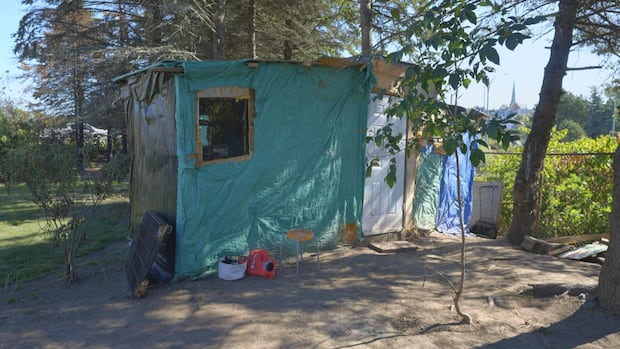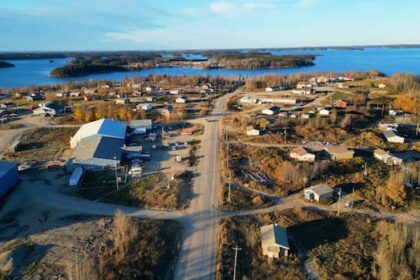New BrunswickIt’s been weeks since Saint John decided to move homeless encampments out of areas where they’re banned under the city’s Housing For All strategy. Some people still aren’t sure where they can move or whether they’ll still have access to key services. Some encampment residents don’t know where they can live or how they’ll access essential servicesNipun Tiwari · CBC News · Posted: Oct 17, 2025 6:09 AM EDT | Last Updated: 1 hour agoSome residents of encampments and people helping them relocate still aren’t clear on where tents will now be allowed in Saint John. (Graham Thompson/CBC)It’s been weeks since Saint John decided to relocate homeless encampments from “red zones,” the areas where tents are banned under the city’s Housing for All strategy. “For a lot of people we’re talking to, there’s interest in going outside of red zones,” said Melanie Vautour, executive director of Fresh Start Services, a non-profit providing outreach workers to help implement parts of the Housing for All plan. But some people still aren’t sure where they can move and safely set up tents or whether they’ll still have access to key services, she said.Fresh Start is working out some of the details of the relocation plan.The same plan includes “green zones,” which are transitional housing sites and “yellow zones,” sites where encampments are permitted. A green zone site started operating in August. Another is to launch in early November — a month earlier than planned.But the precise areas where tents are allowed have been unclear on the city-provided map Fresh Start is using.The red zone strategy is part of the city’s Housing For All plan. Encampment prohibiting red zones take up a large portion of the uptown area but Fresh Start and staff say relocations will depend on individual situations. ‘Yellow zones’ are areas where encampments are permitted. City staff have said areas not marked as ‘red’ or ‘green’ on the city-provided map are considered yellow zones. (City of Saint John)City staff have said that areas not clearly marked as “red” or “green” are considered yellow zones. These include some city-owned land and private property where permission has been granted for tents. The lack of specific locations has created confusion.“It’s not like the map is showing where they could go in the city,” Vautour said. “Property lines aren’t necessarily spray-painted for people to know, ‘I can go here, I can’t go there.’”Melanie Vautour of Fresh Start Services says her team has seen interest in leaving the areas marked as red zones, but there is confusion about where people can go and how they’ll access services such as meal programs. (Nipun Tiwari/Zoom)City staff have previously said these yellow sites will aim to offer amenities such as heating and bathrooms. Vautour said Fresh Start is working with the city to identify the yellow zones where people can still access services such as meal programs and transportation.“This is not pushing people out of the city or out of certain areas,” she said.“It’s more about finding better spaces for them, where they can still access support and also [about] looking at if they do have needs that require them to be closer to uptown.”Vautour said some sites have been identified but these won’t be revealed for the safety of those living in them.“The truth is there are people who look for the unsheltered for not always the right reasons,” she said. “So we don’t share location sites where we know people are.”WATCH | Plan isn’t to push homeless people out of city, non-profit head says :Saint John plan to bar encampments from ‘red zones’ now in full swingEncampments are relocating as part of Saint John’s red zone plan prohibiting them from certain areas, but some homeless residents find the plan unclear. The red zone plan was approved by council on Sept 22. Some members of the public opposed it, arguing it would ban tents from too many areas and push unhoused people to the city’s outskirts.The city’s goal is to reduce visible homelessness by mid-November. Initial steps have focused on helping residents clean up sites and meeting with people in red zones to create individualized plans to relocate.“We’ve been [talking to people in red zones] about changes and just looking at that individualized planning with each person,” Vautour said.“Who’s interested in going to different areas? Who maybe needs more time to get resources in place?”Several people have already moved. Another community group, Street Team SJ, has questions about how its own work will be affected. The small group provides essentials such as food, clothing, sleeping bags and heating supplies to about 24 encampment residents.Co-founder Ivan McCullough said the people the group serves are mostly in red zones, and he’s seen “trepidation,” anxiety, and even anger as the plan rolls out.Ivan McCullough says his group, Street Team SJ, has questions about how its work will be affected by the relocation of encampments from red zones. (Nipun Tiwari/CBC)Street Team SJ operates from a small space in the city’s north end and its work requires knowing where encampment residents are located.“That’s a little bit up in the air because at the moment, we don’t know where the new yellow zones are going to be,” he said.“Until that time, we’re going to keep functioning as we currently do. And I’m sure we’ll find out one way or another.”People living on encampment sites in Saint John have started moving. At one site, CBC News saw a person dismantling his wooden tent structure, getting ready to leave the area. At another, a person left a sign with moving details. (Nipun Tiwari/CBC)McCullough is glad a group close to the issue is central to implementing the red zones and, like Vautour, is concerned about safety for those in yellow zones.“Are they going to have security to protect them from outside folks [in yellow zones]? Because that’s a problem,” he said.“We get people who have their tents trampled. Housed people who set unhoused people’s tents on fire. They face a lot of violence and stereotyping, which is sad.” McCullough said dismantling some tents won’t be simple since many are more like makeshift homes.Taking tents down won’t be a simple task as some tents are full structures that are more like make shift houses with some or most of it put together with wood. (Graham Thompson/CBC)Dave McLaughlin has lived in an encampment near uptown for two years. His tent and others are more permanent setups — some made entirely of wood and some tarp on wooden frames.Sites near Crown Street, Garden Street and Paradise Row still had tents and structures but very few people present when CBC News visited the areas this week. All showed early signs of being cleared.McLaughlin, who was tearing his structure down at the time, said no one has asked him to relocate yet, but he started anyway. He’s been speaking with Fresh Start with hopes of being placed in housing. In the meantime, he said, he’s trying to help others at his site find new places.“I’m hoping we don’t get these torn down,” he said of the surrounding tents. “It’s never been a problem before, but now that it’s a red zone, we have go to clean that up and have nothing there.”At one site, a sign on a tent read, “Be right back to finish moving tent and cleaning,” asking for patience.Aside from a mid-November deadline the city and Fresh Start are also preparing for winter, a large task for a team of eight.In August 218 people were chronically homeless in Saint John, according to the Human Development Council’s most updated numbers. ABOUT THE AUTHORNipun Tiwari is a reporter assigned to community engagement and based in Saint John, New Brunswick. He can be reached at nipun.tiwari@cbc.ca.
Saint John homeless encampments are moving, but where to isn’t clear











